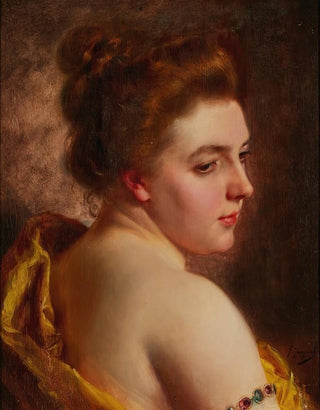Art print | White shoulders - Gustave Jean Jacquet


View from behind

Frame (optional)
In the fascinating world of art, some works transcend time and capture the very essence of humanity. "Shoulders White - Gustave Jean Jacquet" is one of those creations that, through its beauty and depth, invites the viewer to introspective contemplation. This piece, emblematic of the late 19th century, evokes an atmosphere of delicacy and mystery. Immersing oneself in this universe reveals not only an aesthetic representation but also a reflection on the human condition, emotions, and interpersonal relationships. Jacquet's technical mastery, combined with his keen sense of observation, makes this artwork a true masterpiece that continues to inspire awe.
Style and uniqueness of the work
The work "Shoulders White" stands out for its unique style, blending realism and impressionism. Jacquet excels in depicting textures and lights, creating a palpable atmosphere. The delicate nuances of the model's skin, contrasting with the darker background, immediately draw the eye and evoke a deep emotion. The meticulous details, such as reflections in the hair and the fluidity of the drapery, testify to exceptional craftsmanship. Every brushstroke seems loaded with meaning; every shadow and light tells a story. This painting, with its harmonious composition and subtle use of colors, invites an enriching visual experience where one can almost feel the living presence of the depicted figure.
The artist and his influence
Gustave Jean Jacquet, a prominent figure in French painting, established himself through his exceptional talent and artistic vision. Born in 1846, he evolved within a rich artistic environment, influenced by the great masters of his time. His ability to capture the essence of his subjects while incorporating contemporary elements made him a pioneer in figurative art. Jacquet was also a keen observer of society, and his works often reflect the concerns and aspirations of his era. His influence is felt not only in his own creations but also among many artists who followed in his footsteps. "Shoulders

Matte finish

View from behind

Frame (optional)
In the fascinating world of art, some works transcend time and capture the very essence of humanity. "Shoulders White - Gustave Jean Jacquet" is one of those creations that, through its beauty and depth, invites the viewer to introspective contemplation. This piece, emblematic of the late 19th century, evokes an atmosphere of delicacy and mystery. Immersing oneself in this universe reveals not only an aesthetic representation but also a reflection on the human condition, emotions, and interpersonal relationships. Jacquet's technical mastery, combined with his keen sense of observation, makes this artwork a true masterpiece that continues to inspire awe.
Style and uniqueness of the work
The work "Shoulders White" stands out for its unique style, blending realism and impressionism. Jacquet excels in depicting textures and lights, creating a palpable atmosphere. The delicate nuances of the model's skin, contrasting with the darker background, immediately draw the eye and evoke a deep emotion. The meticulous details, such as reflections in the hair and the fluidity of the drapery, testify to exceptional craftsmanship. Every brushstroke seems loaded with meaning; every shadow and light tells a story. This painting, with its harmonious composition and subtle use of colors, invites an enriching visual experience where one can almost feel the living presence of the depicted figure.
The artist and his influence
Gustave Jean Jacquet, a prominent figure in French painting, established himself through his exceptional talent and artistic vision. Born in 1846, he evolved within a rich artistic environment, influenced by the great masters of his time. His ability to capture the essence of his subjects while incorporating contemporary elements made him a pioneer in figurative art. Jacquet was also a keen observer of society, and his works often reflect the concerns and aspirations of his era. His influence is felt not only in his own creations but also among many artists who followed in his footsteps. "Shoulders






